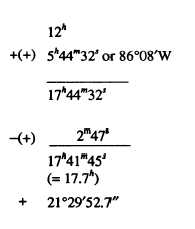Observatory, is shown in table 15-4. The Solar
Ephemeris is issued (on request) each year by major
engineering instrument makers.
Find the sun’s declination as follows:
1. Accepting the observation as having been made
at the meridian, record the local apparent time as 12“.
2. Add the longitudinal equivalent time to obtain
Greenwich apparent time (GAT).
3. Add or subtract the equation of time (true solar
time minus local civil time) from GAT to obtain GMT
(Greenwich mean time). The equation of time is given
in the Solar Ephemeris or Nautical Almanac for the
instant of Oh (midnight) daily at Greenwich for the whole
year.
4. Correct the apparent declination for the date for
the elapsed GMT from O“.
5. In case the local standard time of the observation
is recorded, find the GMT at once by simply adding the
time zone difference. Then, after all the necessary
corrections are made, substitute the value to one of the
formulas enumerated above, analyzing carefully to see
which formula is appropriate.
EXAMPLE: Suppose that on 28 May 1985 in the
Northern Hemisphere, you obtained a corrected
meridian altitude (h) of the sun of at longitude
86°08’W. The sun bears south of the observer. The
computation to get the corrected declination is as
follows:
Local apparent time
Longitudinal
equivalent time
Greenwich apparent
t i m e
Equation of time
Greenwich mean time
(GMT)
Declination at
(table 15-4)
NOTE: 23.94” = Difference for 1 hour (table 15-4)
Correction for elapsed
7’03.7”
Corrected declination
21°36’56.4”
From the computation shown above, you see that
the declination is positive, so it is a north declination.
The transit was pointed south, so this is a case in which
the body observed was between the zenith and the
equator. This is, then, a Case I situation, in which the
latitude equals declination plus zenith distance
or 22°22’54”). Therefore, the latitude
is equal to
SUN OBSERVATIONS FOR AZIMUTH
Sun observations, as compared with star
observations, provide the surveyor with a more
convenient and economical method for determining an
accurate astronomic azimuth. A sun observation can be
easily incorporated into a regular work schedule. It
requires little additional field time, and when reasonable
care is exercised and proper equipment is used, an
accuracy within 10 seconds can be obtained.
Two methods are used for determining an azimuth
by observing the sun: the altitude method and the
hour angle method. The basic difference between
these two is that the altitude method requires an
accurate vertical angle and approximate time,
whereas the hour angle requires a very accurate time
but no vertical angle.
In the past, the altitude method has been more
popular primarily because of the difficulty of
obtaining accurate time in the field. The develop-
ment of time signals and accurate timepieces,
particularly digital watches with split time features
and time modules for calculators, has eliminated
this obstacle to the extent that the hour angle
method is now preferred. The hour angle method is
more accurate, faster, requires less training for
proficiency, has fewer restrictions on time of day
and geographic location, has more versatility
(total-station instruments may be used), and is
applicable to Polaris and other stars.
To apply the hour angle method, you measure
the horizontal angle from a line to the sun. Then,
knowing the accurate time of observation and your
position (latitude and longitude), you can compute
the azimuth of the sun. This azimuth is then
combined with the horizontal angle to yield the
azimuth of the line.
To compute the azimuth of the sun, use the
following equation:
15-17





